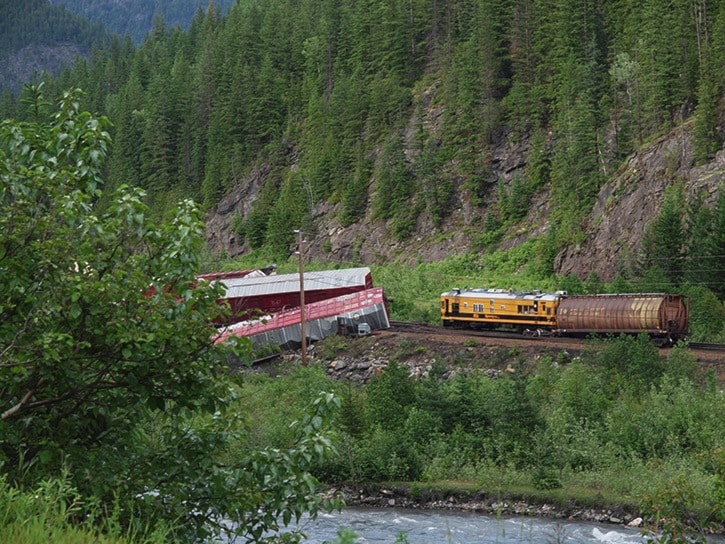Nobody has a greater personal stake in train safety than the people who drive them. The engineers and conductors who guide the trains out of Revelstoke and up into the Rocky Mountains deal with the risks day in, day out.
As part of our ongoing rail safety series, the Times Review spoke with Revelstoke rail personnel to hear their concerns.
CP Rail staff are prohibited from speaking to the media, risking severe repercussions and even dismissal. We granted anonymity to CP staff who spoke with us because we felt we couldn't get to the core of local concerns without doing so. Their identities are known only to this author and will remain so.
***
Not all derailments are made public. Minor derailments, like one car skipping a track, fly under the radar. They certainly don't get an official Transportation Safety Board investigation, which is reserved for major incidents. Rail operators don't publicize incidents, large or small.
But those minor incidents can point out a troubling trend.
Last Sunday, July 14, a single car skipped the track in the Illecillewaet River area. On June 14, a train skipped the rails in the spiral tunnels.
The issue, local running trades staff said, were new CP Rail efforts to push for longer trains – a practice that has increased over the past year since new CP Rail CEO Hunter Harrison embarked on an aggressive efficiency drive designed to please investors.
The longer trains, which now routinely run over 10,000 feet – or about two miles long – create several issues and concerns.
One is inadequate or improper marshalling, train engineers said. Marshalling refers to the act of putting the trains together, composing them of their constituent wheat cars, box cars, chemical containers, potash cars, specialized cargo carriers and so on.
The drive to make trains longer and therefore reduce the number of crews has led to unsafer trains. Much, much longer and heavier trains are part of the issue, especially in the mountain passes through Revelstoke. The problems are compounded by extreme winter mountain weather.
The engineers said the main issue is building safe trains becomes more difficult the longer the train is. Generally, heavier cars are placed near the front of the train, while lighter or empty cars are put in the back. Mixing light and heavy cars intermittently can be dangerous because it complicates in-train forces. The longer the train, the more difficult it can be to perform the complex task of marshalling the trains appropriately.
Local engineers say a push for efficiency has compounded the issue; in a climate of thousands of layoffs at CP Rail in past years, marshalling yard workers succumb to the pressure, accepting poor decisions in the name of efficiency and keeping the trains moving.
Engineers said the recent derailment near the Illecillewaet River was caused by an unloaded box car located too near the front of the train, where it shouldn't have been. Under stress from braking and extreme "in train forces” the car was insufficiently weighted down and popped off the rails. Fortunately, that’s all that happened. “It’s one of those smoking guns. Those are the warning signs that you are pushing it,” said one engineer.
While trains over 12,000 feet may be okay in the flat Prairies, or foothills, engineers here are concerned the drive for longer trains will end with a disaster here, with our steeper grades and snaking curves.
“I don’t know how long a train you can drive across Saskatchewan,” said one engineer. “Revelstoke is the proving ground. Revelstoke will be the weak link, for sure.”
Isn’t Transport Canada responsible for regulating appropriate lengths and marshalling practices? “They’re not very proactive, let’s put it that way,” said one engineer. Transport Canada and its political masters weigh safety as one concern, but also seek to reduce transportation costs. “As far as the feds are concerned, the more you can keep that transportation cost under control, the more competitive those goods are,” said one engineer about Transport Canada oversight.
Longer trains underpowered, engineers say
Engineers complained the longer trains are sometimes inadequately powered, not having enough locomotives at the front, middle and back for some of the new, longer trains. In addition to pulling the train, the locomotives also power the braking system. Engineers said the issue arises in complicated descents requiring more complex braking.
Put simply, the compressors that power the brakes need time to recharge after being used. Longer trains powered only at the head were flagged as a concern.
Engineers said the situation is often manageable, but equipment malfunctions and other mechanical adversity sometimes lead to nail-biting situations. "It's scary as hell," said one.
Move to 24-hour rest period main concern
Revelstoke engineers identified CP Rail's desire to make Revelstoke staff revert to a 24-hour rest period as a key safety concern.
Currently, in most of Canada, rail crews get 24 hours of rest between shifts before being required to be back at work.
In Revelstoke, the fatigue management plan has allowed for 30 hours for Revelstoke home terminal workers.
Dave Able is the general chairman of the Teamsters Canada Rail Conference for train engineers in western Canada. He explained that the system was instituted decades ago to accommodate the special considerations of local conditions. They include steeper grades and slower sections that are more demanding.
Layoffs prompted by CP Rail's efficiency drive – believed to total about 60 in Revelstoke – have compounded the issue already. The crews that are working work more often, and are required to be back on shift after the minimum rest period more often.
If required to move to 24 hours minimum rest, Able and the engineers we spoke with pointed to increased hazards due to fatigue.
Above and beyond longer train lengths, the company's push for shorter rest periods was their chief safety concern.
